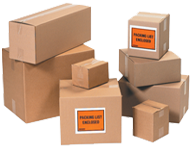24-26"
 |
Hundreds of Box Sizes Available!- Cartons are sold in bundle quantities- Shipped flat to save on storage space and shipping. - Single Wall ECT32 |
 |
| Shop By Length: 3-8" | 9-11" | 12-13" | 14-17" | 18-23" | 24-26" | 27-48" | ||
| For volume/bulk pricing and lower LTL rate quotes call 800-878-7703 or fill out the form. | ||
| SKU | Size | STRENGTH / DEPTH | Price | Tier Pricing | BUNDLE/ BALE QTY. | Add to Cart | |||
|---|---|---|---|---|---|---|---|---|---|
| 100 | 250 | 500 | 1000 | ||||||
| BOX24241210 | 200 lb. / ECT32 | $66.36 | $66.36 | $66.36 | $66.36 | $66.36 | 10/120 | ||
| BOX241212 | 24 x 12 x 12" | ECT32 | $2.85 | $2.79 | $2.00 | $1.97 | $1.85 | 20/240 | |
| BOX241818 | 24" x 18" x 18" | ECT32 | $4.53 | $4.53 | $4.53 | $4.53 | $4.53 | 10/120 | |
| BOX242412 | 24" x 24" x 12" | 200 lb. / ECT32 | $6.62 | $6.62 | $6.62 | $6.62 | $6.62 | 10/120 | |
| BOX242424D | 24" x 24" x 24" | 275# Double Wall | $15.75 | $15.12 | $14.49 | $13.86 | $13.39 | 5/120 | |
| BOX242424 | 24"x24"x24" | ECT32 | $9.84 | $9.54 | $9.35 | $9.05 | $8.86 | 5/120 | |
Measuring the Width, Height, and Length of Shipping Boxes
It is a fact that you will pay the shipping package according to its size. If you want to ensure that you are paying the right shipping amount, you must know how to measure the height, width, and length of the boxes used for shipping. With this, you also need to have the right measuring tool to find the measurement of the box. It can help you to determine the metrics of the box and know if you are paying the right amount of shipping fees. To know more about measuring shipping boxes, read further.
Measuring an ordinary package’s measurement
- Measure the package’s longest side.
The first thing to know the measurement of an ordinary package is to understand its longest side. Next, hold the tape measure or ruler on the edge of the box. With this, you can check the total length from end to end. Then, round it off to its nearest one inch (2.5 cm). For reference later on write down the measurements or record in your computer software. The length is the most important measurement on the packages. Most shipping carriers only handle packages on a specific size which is written in inches. As an example try measuring flat boxes, long boxes or tall corrugated boxes.
2. Turn your measuring tool to get the width to 90 degrees.
Measure the width of the box. It is the measurement from one wall of the box’ shortest side to its opposite wall. Extend the tape from end to end and round to its nearest inch. Measuring the width can have more chances of having a margin of error compared to lengtth
3. Measure the height of the box by holding the measuring tool vertically.
Determine the dimension of the box from bottom to top. Then, round its size to its nearest inch. Height is commonly the smallest measurement of the box.
4. Double the height and width and add it together to find the circumference of the box.
See the measurements then, multiply its height as well as width dimensions by two. Next, add the multiplied height and multiplied width together. The result will be the box’ estimated girth. The circumference is the total distance around the box’ broadest part.
5. Measure the girth and combined length to know the size of the total package.
There are some instances that you will be asked for the package’ overall size. To know the total package, add the girth and length measurements together.
Meanwhile, you must also know how to measure the dimensional weight of the shipping box.
Measuring the package’s dimensional weight
1. Calculate the package’s width, length, as well as height.
Use a tape measure or ruler to determine the longest side, standing sides, and shortest side of your package. Then, estimate to the closest inch.
2. Multiply the width, length, and height of the package to know its cubic size.
Cubic size is also like the volume that determines the space on the box. You can do this by multiplying the dimensions of the box.
3. Divide its cubic size to its divisor to know its dimensional weight.
The cubic size of the box can determine the cost of the shipping process.
4. Weigh the package through postage scale.
Place the package on the postage scale to know its actual weight.
- 5. Compare the actual weight or dimensional weight.
If the actual weight is less than the dimensional weight, it is considered as billable weight.




